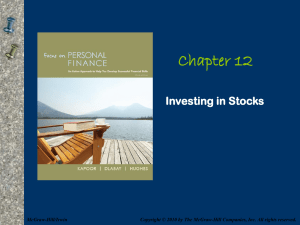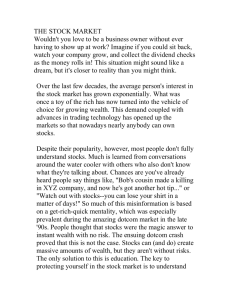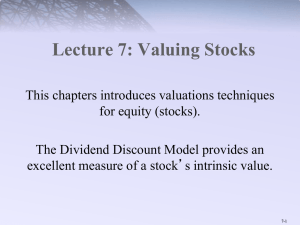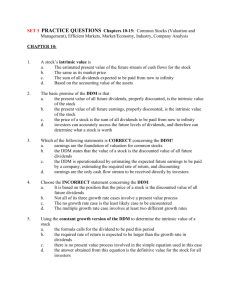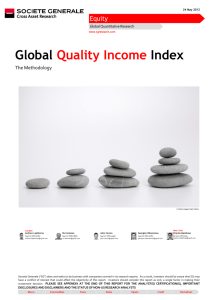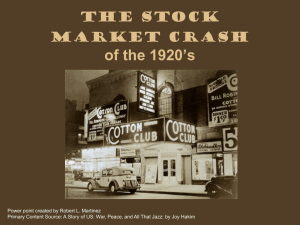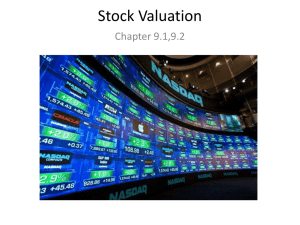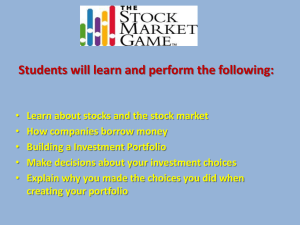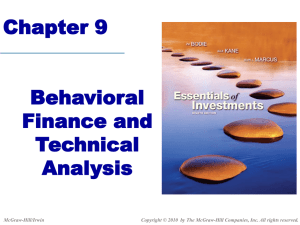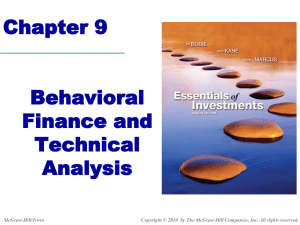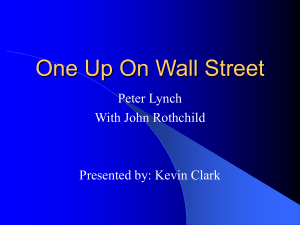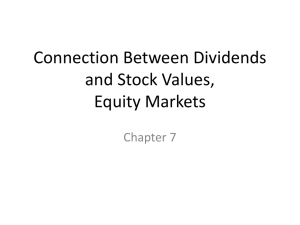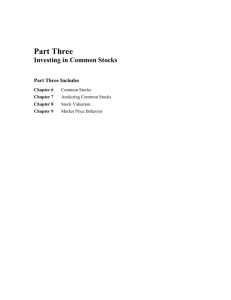Chapter 12: Investing in Stocks
advertisement
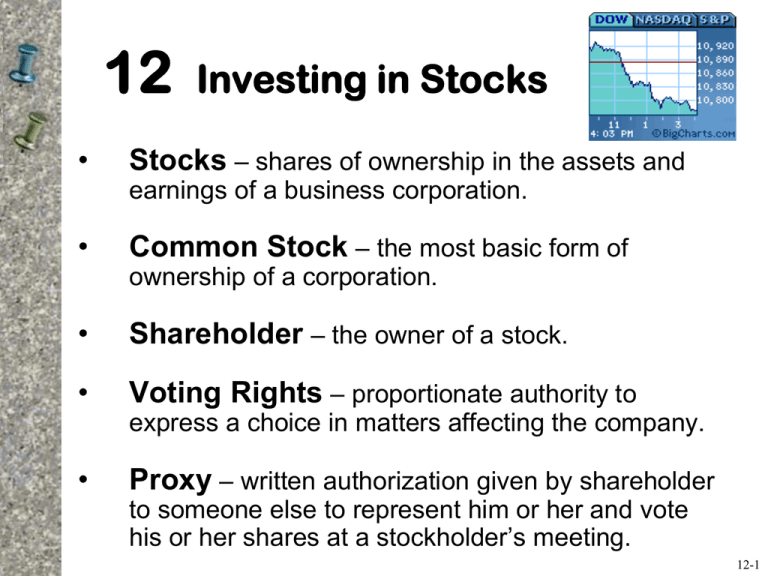
12 • Investing in Stocks Stocks – shares of ownership in the assets and earnings of a business corporation. • Common Stock – the most basic form of ownership of a corporation. • Shareholder – the owner of a stock. • Voting Rights – proportionate authority to express a choice in matters affecting the company. • Proxy – written authorization given by shareholder to someone else to represent him or her and vote his or her shares at a stockholder’s meeting. 12-1 Objective 1 Identify the Most Important Features of Common and Preferred Stocks • Two types of stock – Common Stock- provides investors with an ownership interest in a corporation or (growth oriented) – Preferred Stock- a cross between a stock and a bond (income oriented) • On average, common stocks have outperformed all other assets over time • Need to be patient and do research 12-2 Why Corporations Issue Common Stock • Common Stock = most basic form of corporate ownership • Stock = equity financing • Reasons why corporations issue stock – Raise money to start or expand business – Pay ongoing business expenses – Need not repay the money (like bonds) – Dividends (distributions to shareholders) not mandatory • Board of Directors votes each dividend payment • But: – Shareholders have voting rights; control of company – Management must often make concessions 12-3 Why Investors Purchase Common Stock Investors can make money in three ways – Income from dividends – Dollar appreciation of stock value • Price appreciation = capital gain – Possible increased value from stock splits • No guarantee price will go up after a split • Stock Split – when the shares of stock owned by existing shareholders are divided into a larger number of shares; done to change (lower) price – • Example: 2:1- twice as many shares worth half as much A reverse stock split results in smaller number of shares. – Example: 1:2- half as many shares worth twice as much 12-4 Dividend Dates • Declaration Date = Board of Directors votes to pay a dividend (usually quarterly) • Record Date = A stockholder must be registered on the firm’s books to receive the dividend • Ex-Dividend Date = 2nd day before the record date; stock begins to trade without the dividend – Investors buying after the ex-dividend date do not receive a dividend for that quarter • Payment Date = Dividend is paid to investors 12-5 Preferred Stock • Hybrid Security – Known cash dividend is about equal to bond interest – Equity position is about equal to common stock but usually non-voting; low % of all stock issued • Dividends paid before common stock – Dividend may be omitted • Cumulative Preferred Stock – Unpaid cash dividends accumulate – Must be paid before any cash dividends are paid to common stockholders (versus noncumulative preferred stock) • Convertible Preferred Stock – Can be traded for shares of common stock – Provides investor with added safety of preferred stock and greater speculative gain through conversion to common stock 12-6 Classifications of Stocks • Income Stock – may not grow too quickly, but pays a cash dividend higher than that offered by most companies year after year. – Example: utility companies • Growth Stock – a company that offers the promise of much higher profits tomorrow and has a consistent record of relatively rapid growth in earnings in all economic conditions. – Example: technology companies More Classifications of Stocks • Speculative Stock – a company that has a potential for substantial earnings in the future. • Blue-Chip Stocks – a company that has been around for a long time, has a well-regarded reputation, dominates its industry, and is known for being a solid, relatively safe investment. • Value Stock – a company with stock that is selling for less than the true worth of its assets. Other Characterizations for Common Stocks (continued) • Cyclical Stocks – stock from a company whose profits are greatly influenced by changes in the economic business cycle. – Examples? • Countercyclical (or Defensive) Stocks – stock from a company that performs well even in an environment characterized by weak economic activity. – Examples? Objective 2 Explain How You Can Evaluate Stock Investments • The Internet – Firm’s home page more current than printed materials – http://finance.yahoo.com • Stock Advisory Services – Most charge a fee – Three most popular: Standard and Poor’s reports, Value Line and Mergent’s Handbook of Common Stock • Prospectus- Lists all necessary information as dictated by the Federal government • Annual Report- All publicly traded corporations send to their stockholders • Securities and Exchange Commission Web site (http://www.sec.gov) • Business Periodicals: – Business Week, Fortune, Forbes, Money, Smart Money, Kiplinger’s Personal Finance Magazine 12-10 Objective 3 Analyze the Numerical Measures that Cause a Stock to Increase or Decrease in Value • Corporate Earnings – One of the most significant factors in changes in the value of a stock • Earnings per share (EPS) – Formula: Corporation’s after-tax income divided by number of outstanding shares of common stock – Example: $5,000,000/10,000.000 = $0.50 – EPS Increase = generally a healthy sign 12-11 Numeric Measures That Influence Investment • Price-Earnings Ratio (PE) – Price per share of stock divided by the firm’s earnings per share – Example: $10 price/0.50 EPS = a PE ratio of 20 – Tells how much an investor is paying for a company’s earning power – P/E > 20 investor optimism – P/E < 20 lower earnings expectations – Compare to firms in same industry • Projected Earnings – EPS and PE based on historical data – Future expectations more relevant 12-12 Common Stock Price Quotes Last trade price = $44.37 Annual dividend = $1.68 P/E = 15.41 Earnings per share = 44.37/15.41 = $2.8793 12-13 Other Factors than Influence the Price of a Stock • Dividend Yield – Annual dollar dividend divided by current price per share – Dividend yield increase = healthy sign • Total Return – Dividends plus capital gains – Cash income + Price appreciation • Book Value per Share – (Assets – Liabilities)/ # shares (net worth of company) – Market price per share should be > book value 12-14 Objective 4 Describe How Stocks are Bought and Sold Primary Market • Investor buys securities from issuer of those securities via an investment bank – Investment bank = financial firm that assists corporations in raising funds, usually by helping sell new security issues (underwriting) • IPO = when a corporation sells stock to general public for first time – Cash from security sales goes to issuing company – Generally considered a high-risk investment Secondary Market • • • Market for existing financial securities Traded among investors via brokers and dealers Markets – Stock exchanges (NYSE, foreign securities exchanges) – Over-the-counter markets 12-15 Secondary Markets for Stocks Securities Exchanges (NYSE) • Marketplace where members, representing investors, meet to buy and sell securities (almost 4,000 companies) • Securities sold on an exchange must be listed, or accepted for trading, on that exchange • “The Listed Market” = NYSE • “Specialist” buys or sells a particular stock The Over-the-Counter (OTC) Market (NASDAQ) • Network of dealers who buy and sell the stocks of companies from inventory (several thousand companies) – Dealer = “Market Maker” • NASDAQ = electronic marketplace for over 3,200 companies 12-16 Brokerage Firms and Account Executives • Account Executive (Stockbroker) – Licensed individual who buys and sells securities for his or her clients • Churning – Excessive buying and selling of securities to generate commissions – Illegal under SEC regulations – Can be difficult to prove; clients subject to arbitration 12-17 Discount vs. Full Service Brokers Service vs. Cost • How much advice do you want? • Can you buy and sell stocks over the phone? • Can you trade stocks online? • Where is the nearest office located? • Toll-free number for customer use? • How often are statements issued? • Is there a charge for statements, research and other financial reports? reports, • Are there any fees in addition to commissions to buy and sell? 12-18 Computerized Transactions Reasons that justify trading online: 1. Size of investment portfolio 2. Ability and desire to manage own portfolio 3. Ability to monitor investments closely 4. Capability of computer and software 12-19 Stock Transaction Orders • Market Order – Request to buy or sell stock at the current market value • Limit Order – Request to buy or sell a stock at a specified price • Stop Order (Stop-loss order) – Request to sell a stock at the next available opportunity after its market price reaches a specified amount – Can lose a lot of money in a “flash crash” • Brokerage minimum commissions – Range = $7 to $35 – Depends on the number of shares traded and stock value • Full service vs. discount brokers – Full service fees > 1% to 2% of transaction amount – Online broker little advice or service 12-20 Objective 5 Explain the Trading Techniques Used by Long-term Investors and Short-term Speculators Long-Term Investment Strategies • Buy and hold • Dollar cost averaging • Direct investment and dividend reinvestment plans (DRIPS) – http://www.directinvesting.com – http://www.dripcentral.com 12-21 Dollar Cost Averaging • Long-term technique • Invest equal dollar amount in the same stock at equal intervals • Goals: – Minimize average cost per share – Avoid “Buy High – Sell Low” Year Investment 2006 2007 2008 Total Average $2,000 $2,000 $2,000 $6,000 Stock Price Shares Purchased $60 $68 $58 33.3 29.4 34.5 97.2 $61.73 12-22 Short-Term Investment Strategies • Buying Stock on Margin – Borrowing money from broker – Margin requirement set by the Fed – “Bullish” (expect stock price increase) • Selling short – Borrowing stock to sell – “Sell high, buy low” – “Bearish” (expect stock market decrease) 12-23 Wrap Up • Chapter Quiz • Concept Check 12-1- Common Stock and Preferred Stock • Concept Check 12-2-Prospectus and Annual Report • Figure It Out- Earnings per Share, PE Ratio, Dividend Yield • Concept Check 12-4- How Would You Buy Stock?

